30 May to 5 June, 2013 – Bergama, Pergamum, Selçuk, Ephesus, Priene, Miletus, Didyma, Pamukkale, Afrodisias – (Turkey)
Walking along the street in Selçuk, we were privileged to witness one of the cutest sights ever. An elderly Turkish couple were standing on the footpath, engaged in conversation. I don't know what exactly drew our attention to them, but we started discussing them, hypothesising what they might be talking about. Suddenly, the man grabbed the plump lady, and heaved her up so she could sit on the brick fence they were standing at. It still makes us smile to think back to that.
So, now we are in the south western part of Turkey. The ruined cities have become our focus. Hellenistic; Roman; Byzantine; Lycian. Some two thousand year old structures are incredibly intact, others look fabulous after incredible restorations, there are some which are suffering from questionable preservation efforts, but the majority are left with their enormous decorated stones laying exactly where archaeologists have uncovered them. Pillars jut out of the ground, carved lintels are stepping stones to aid climbing, and enormous slabs of fallen marble create a maze among the foundations of ancient walls. Here are some photos from this part of the world. More to come in the next installment.
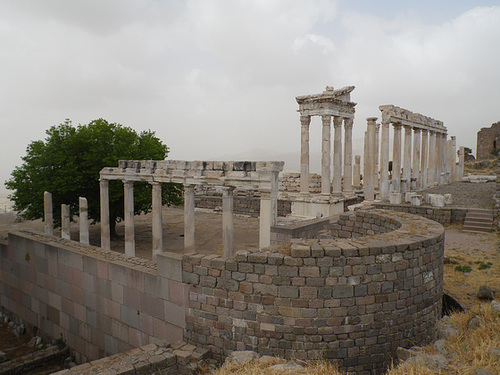
The Temple of Trajan, Pergamum
Marble columns of the Roman built temple in Pergamum's acropolis.
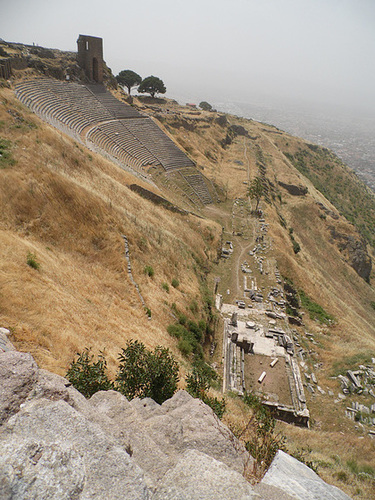
A Very Impressive Hellenistic Theatre, Pergamum
The 10,000 seat theatre of Pergamum.

A Scattered Piece
A beautifully carved piece from a temple in Pergamum, amongst a large number of scattered pieces, waiting to be pieced together once more.
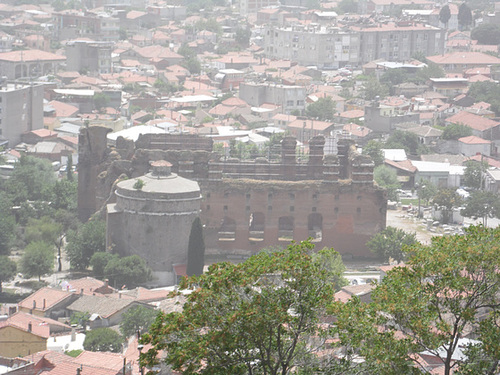
The Red Basilica of Pergamos
In Revelation, John addresses the church of Pergamos (Pergamum), one of the seven churches of the apocalypse, as the place “where Satan's throne is” (Revelation 2:13). This building was a pagan temple, built to a number of gods (principally Egyptian). Eventually, it became Christian, and an entire basilica was built inside the old temple.

Going Nowhere
More ruins of Pergamum, this motorbike and sidecar look like they haven't moved for a long time. Although, they probably are not Roman. I'm not sure about the cat, either, who seems to like the idea of staying put.
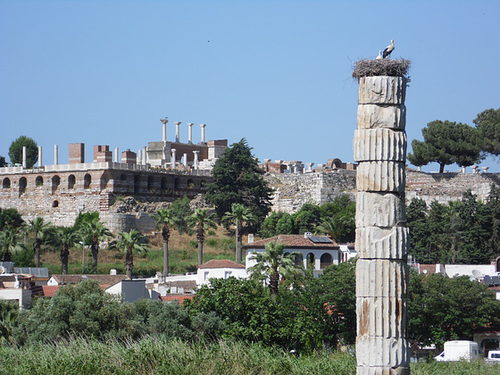
Stork Nest Atop an Ancient Pillar
The pillar is about all that remains from the once great Temple of Artemis, the largest in the world in its day, and one of the Seven Wonders of the Ancient World. In the background are the remains of the impressive Basilica of St John, containing the tomb of the apostle.
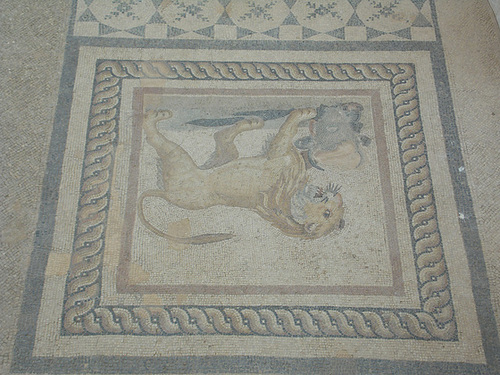
Terrace House Mosaic
One of the beautiful mosaics uncovered in a series of terrace houses, Ephesus.

Library of Celsus, Ephesus
The most famous sight within Ephesus, the facade of the library.
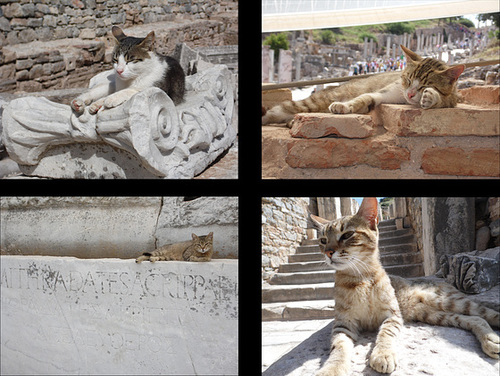
Ephesians, Chapter I
When the apostle Paul wrote to the Ephesians, I don't think he was addressing these residents. Cats don't need encouragement to think bigger and act bigger.
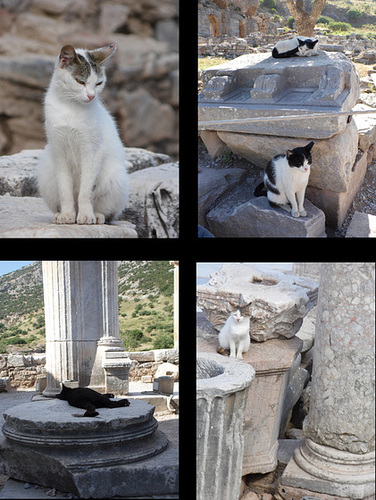
Ephesians, Chapter II
There are so many cats in Ephesus. And they were all sociable, and lounged in picturesque locations in adorable poses. And to think, some people come here to see the ruins.
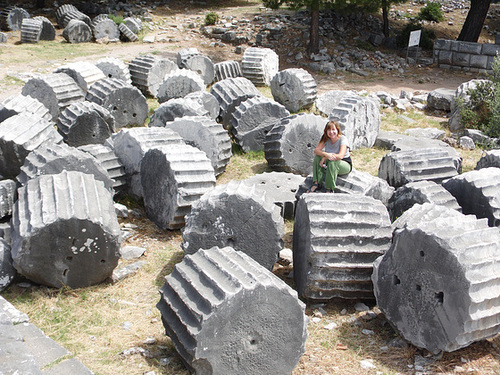
Column Pieces
Looking like giant cogs, pieces of the temple columns lie about, as if they are in the process of being sorted. Temple of Athena, Priene.

The Great Theatre of Miletus
Hellenistic, then updated by the Romans, with a Byzantine castle plopped on top.
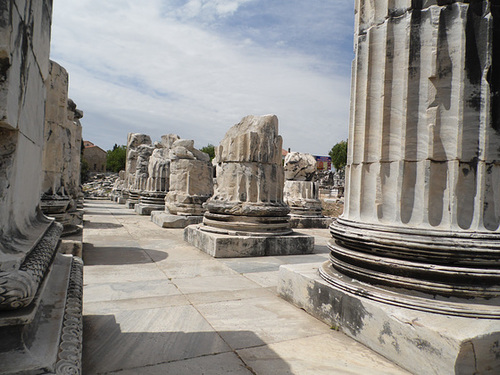
Column Bases
Some of the 124 column bases that remain from what once was the second biggest temple in the world, the Temple of Apollo at Didyma.

Pools of Pamukkale
Some of the upper pools of Pamukkale.
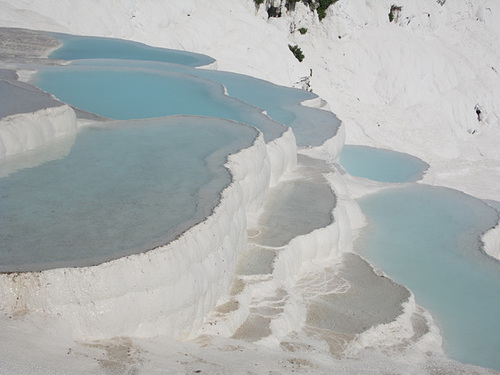
Pamukkale
Looking down at the travertines of Pamukkale. Like a series of saucers, water runs from one to the next, leaving calcite deposits behind which are bleached by the sun.
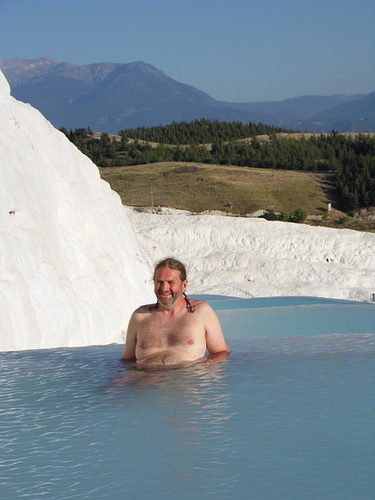
Swimming, Pamukkale Style
Taking a dip in one of the travertines. We were astounded how few people actually took advantage of the opportunity to get in the pools, considering how unique a location Pamukkale is. It didn't worry us, it just surprised us.
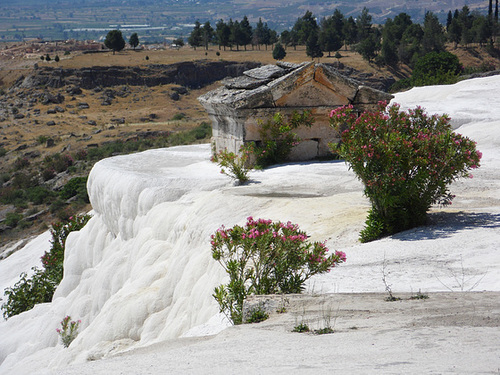
A Tomb on the Clifftop
This tomb, one of many from the necropolis of Hierapolis, is picturesquely situated on the cliff top. The calcite rich waters which create the travertines also run here, leaving the ground with a gleaming white coating.

The Antique Pool of Hierapolis
OK, so it was a tad on the expensive side, but how often do you get the opportunity to swim in a 2000 year old pool with genuine Roman pillars and capitals? In its day, the pool was probably one of the focal points of the city of Hierapolis. I guess back then most of the pillars were around the pool, not in it. However, I think they are a nice touch, giving swimmers somewhere to sit while in the water.
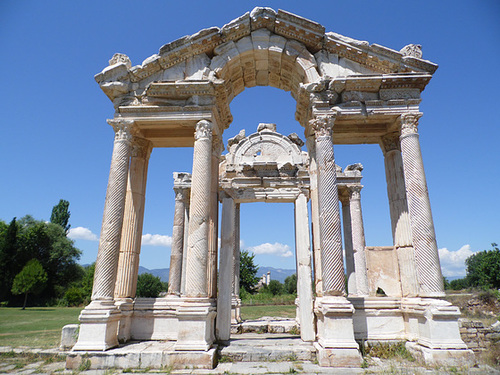
Tetrapylon, Afrodisias
The fantastic gateway in the ancient city of Afrodisias. It has been reconstructed from a very high proportion of original pieces, around 85%. This is much higher than normal, and it makes the gateway a phenomenal sight.
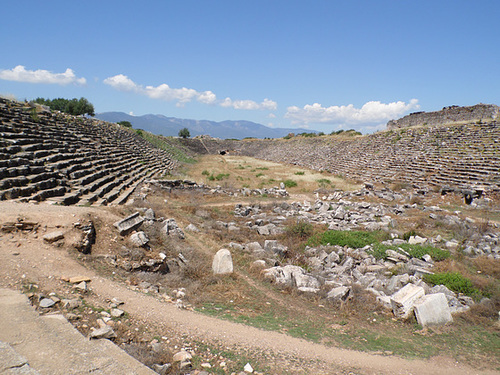
Can You Hear the Crowd?
This Roman stadium, in Afrodisias, was used for many purposes, but the most exciting for our minds to try and imagine is the gladiatorial contests. This is not reconstructed at all, just how it is after all these years without being plundered for building materials. The seats are overgrown, but still clearly defined the whole way around. Gates enter the arena from both ends, and the little boy in me could not resist walking through them, onto the open area, and giving a wave to the imaginary crowd that erupted into an incredible roar. When we told Ben, our nephew, what we had seen, and about the gladiators once fighting here, he asked if there were any bones still lying around. Now, that would have been really cool!
Walking along the street in Selçuk, we were privileged to witness one of the cutest sights ever. An elderly Turkish couple were standing on the footpath, engaged in conversation. I don't know what exactly drew our attention to them, but we started discussing them, hypothesising what they might be talking about. Suddenly, the man grabbed the plump lady, and heaved her up so she could sit on the brick fence they were standing at. It still makes us smile to think back to that.
So, now we are in the south western part of Turkey. The ruined cities have become our focus. Hellenistic; Roman; Byzantine; Lycian. Some two thousand year old structures are incredibly intact, others look fabulous after incredible restorations, there are some which are suffering from questionable preservation efforts, but the majority are left with their enormous decorated stones laying exactly where archaeologists have uncovered them. Pillars jut out of the ground, carved lintels are stepping stones to aid climbing, and enormous slabs of fallen marble create a maze among the foundations of ancient walls. Here are some photos from this part of the world. More to come in the next installment.

The Temple of Trajan, Pergamum
Marble columns of the Roman built temple in Pergamum's acropolis.

A Very Impressive Hellenistic Theatre, Pergamum
The 10,000 seat theatre of Pergamum.

A Scattered Piece
A beautifully carved piece from a temple in Pergamum, amongst a large number of scattered pieces, waiting to be pieced together once more.

The Red Basilica of Pergamos
In Revelation, John addresses the church of Pergamos (Pergamum), one of the seven churches of the apocalypse, as the place “where Satan's throne is” (Revelation 2:13). This building was a pagan temple, built to a number of gods (principally Egyptian). Eventually, it became Christian, and an entire basilica was built inside the old temple.

Going Nowhere
More ruins of Pergamum, this motorbike and sidecar look like they haven't moved for a long time. Although, they probably are not Roman. I'm not sure about the cat, either, who seems to like the idea of staying put.

Stork Nest Atop an Ancient Pillar
The pillar is about all that remains from the once great Temple of Artemis, the largest in the world in its day, and one of the Seven Wonders of the Ancient World. In the background are the remains of the impressive Basilica of St John, containing the tomb of the apostle.

Terrace House Mosaic
One of the beautiful mosaics uncovered in a series of terrace houses, Ephesus.

Library of Celsus, Ephesus
The most famous sight within Ephesus, the facade of the library.

Ephesians, Chapter I
When the apostle Paul wrote to the Ephesians, I don't think he was addressing these residents. Cats don't need encouragement to think bigger and act bigger.

Ephesians, Chapter II
There are so many cats in Ephesus. And they were all sociable, and lounged in picturesque locations in adorable poses. And to think, some people come here to see the ruins.

Column Pieces
Looking like giant cogs, pieces of the temple columns lie about, as if they are in the process of being sorted. Temple of Athena, Priene.

The Great Theatre of Miletus
Hellenistic, then updated by the Romans, with a Byzantine castle plopped on top.

Column Bases
Some of the 124 column bases that remain from what once was the second biggest temple in the world, the Temple of Apollo at Didyma.

Pools of Pamukkale
Some of the upper pools of Pamukkale.

Pamukkale
Looking down at the travertines of Pamukkale. Like a series of saucers, water runs from one to the next, leaving calcite deposits behind which are bleached by the sun.

Swimming, Pamukkale Style
Taking a dip in one of the travertines. We were astounded how few people actually took advantage of the opportunity to get in the pools, considering how unique a location Pamukkale is. It didn't worry us, it just surprised us.

A Tomb on the Clifftop
This tomb, one of many from the necropolis of Hierapolis, is picturesquely situated on the cliff top. The calcite rich waters which create the travertines also run here, leaving the ground with a gleaming white coating.

The Antique Pool of Hierapolis
OK, so it was a tad on the expensive side, but how often do you get the opportunity to swim in a 2000 year old pool with genuine Roman pillars and capitals? In its day, the pool was probably one of the focal points of the city of Hierapolis. I guess back then most of the pillars were around the pool, not in it. However, I think they are a nice touch, giving swimmers somewhere to sit while in the water.

Tetrapylon, Afrodisias
The fantastic gateway in the ancient city of Afrodisias. It has been reconstructed from a very high proportion of original pieces, around 85%. This is much higher than normal, and it makes the gateway a phenomenal sight.

Can You Hear the Crowd?
This Roman stadium, in Afrodisias, was used for many purposes, but the most exciting for our minds to try and imagine is the gladiatorial contests. This is not reconstructed at all, just how it is after all these years without being plundered for building materials. The seats are overgrown, but still clearly defined the whole way around. Gates enter the arena from both ends, and the little boy in me could not resist walking through them, onto the open area, and giving a wave to the imaginary crowd that erupted into an incredible roar. When we told Ben, our nephew, what we had seen, and about the gladiators once fighting here, he asked if there were any bones still lying around. Now, that would have been really cool!
No comments:
Post a Comment